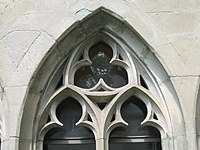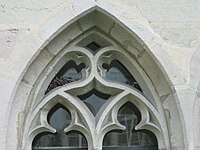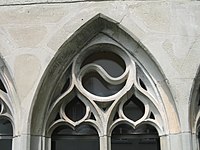Tracery
In architecture, tracery is the filigree work of stonemasons in the form of flat designs of windows , balustrades and open walls. The tracery consists of geometric patterns that are implemented as stone profiles, whereby the stone is completely broken through (skeletonized). If these decorations are placed as a cover on a closed wall surface, one speaks of blind tracery . If they stand free in front of a wall, they are called veil tracery . Vertical struts running in parallel are also referred to as frameworks .
The tracery is an element of Gothic architecture and is one of the most important features of the High and Late Gothic, where it was an indispensable part of the windows. The Gothic used tracery in many other places, for example on the balustrades of the walkways ( triforium ), galleries , on spiers or openwork and prestressed walls in the facade .
In brick buildings, in contrast to the rest of the building, tracery was sometimes made of ashlar , but in some of the bricks that were specially cut before firing , called shaped bricks , or of larger terracotta elements.
The fine tracery had to be stabilized with iron dowels , simple walling with mortar was not enough. For this purpose, thin holes were punched on the joint surfaces to accommodate iron dowels. The remaining cavity was filled with lead . The rods between the lancet windows, some of which are very long, are also connected to one another with horizontal iron rods and divide the windows into rectangular fields that accommodate the individual panes of the stained glass windows. In the case of large and very large windows, the tracery is mainly stabilized by the iron bars, from which the storm iron has the task of absorbing the wind pressure. The tracery on balustrades sometimes consists of rectangular stone panels that have been perforated in the desired shape. In exterior construction, tracery as filigree components are strongly endangered by weathering and are subject to partial or complete replacement depending on the degree of weathering.
history
Before the 'invention' of the tracery, the ever larger glass surfaces of the late Romanesque windows had to be stabilized against wind pressure and dead weight by a large number of - less decorative - iron anchors (example: west window of the cathedral of Le Mans ). The tracery offered clients and architects of the high and late Middle Ages the opportunity to combine aesthetic demands and technical necessities into a unit that would last for centuries.
The so-called ' wheel windows ' of the late 12th century (Beauvais, St. Étienne; Chartres, Westrose) must be regarded as forerunners of tracery . A pre-form of the tracery is the panel tracery , in which geometrical shapes were carved out of stone slabs as holes so that they appear to be “punched out”, for example in the nave of Chartres Cathedral .
However, one speaks of tracery in the true sense only when the geometric shapes are composed of stone profiles. The first tracery windows can be found in the high Gothic chapels of Reims Cathedral , construction of which began in 1211. The two-lane window in the early Gothic period was further subdivided with increasing size by dividing the two lancets again so that four-lane windows were created. Only later did the builders break away from this strict structure and use any number of lancets of the same size. In a systematically executed tracery, the profile layers of the smaller forms are deeper (i.e. further back) than those of the large forms, which overlap the small ones, so that a hierarchical layering of the tracery forms is created. A special form of the Gothic window is the circular rose , in which the tracery is arranged radially symmetrically.
The Gothic rib vault was occasionally designed as a tracery vault. The caps were not filled, but additional free-standing ribs ("air ribs") were built as tracery in front of the actual vault.
During construction, the tracery was presumably drawn on a plane made of boards, the crack floor, with compasses and cords in original size and then carved in stone. On the crack floor, the window could be assembled as a trial and checked for fit.
Style history
The changes in shape of the tracery are an important means of dividing the architectural history of the Gothic. Terms for style phases are often derived from tracery forms: Rayonnant , French “radiant”, for the high Gothic phase in which the rose windows are divided into radially radiating strips. Flamboyant , French “flaming”, for the late Gothic phase, in which the tracery forms flaming and asymmetrically flickering forms. Decorated , English "decorated", for the Gothic style phase in England, which was characterized by rich tracery decoration. Perpendicular , English "vertical", for the late phase of the English Gothic, in which vertical bars mark the tracery. In the German Gothic, the transition from the high to the late Gothic is also defined by the appearance of curved tracery forms such as fish bladder or snout.
Panel tracery, ceilings window of Chartres Cathedral ,
approx. 1215–1220Tracery window on the choir of Reims Cathedral ,
around 1215–1220Rose window with radial tracery (rayonnant), north transept of Notre-Dame de Paris cathedral , after 1250
Perpendicular Style : Fan Vaults and Windows of Bath Abbey
Flamboyant rose window, south transept facade of Sens Cathedral ,
end of the 15th century.Mixture of Gothic and Renaissance forms at St-Eustache de Paris ,
1532–1633
Tracery forms
three nuns heads
1. u. 2. Three-pass - 3. Four-pass - 4. Five-pass
The windows of the high and late Gothic churches are inconceivable without tracery, as they required an additional structure due to their enormous size. The ogival window typically consists of two or more vertical strips, the so-called lancets , which also end with a pointed arch and usually extend to the height of the arch base. The area above in the arch field is more finely structured with additional geometric figures. It is called Couronnement (French crown, also Germanized: Kronument ). These characters have their own names, e.g. B .:
- Fish bladder ;
- Dreischneuss ;
- Nun's head (two-part tracery);
- Three- or four-pass, including variations thereof: three-, four-leaf, etc .;
- Vielpass , d. H. Five-pass, six-pass, eight-pass, twelve-pass, etc .;
- Figural tracery , e.g. B. the famous three rabbits window in the cloister of the cathedral of Paderborn - the symbol of the city.
use
 |
High Gothic pointed arch windows on the Konstanz Minster |
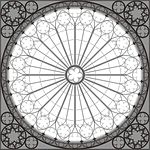 |
Scheme of the large rose in the west facade of the Strasbourg cathedral |
 |
southern transept of Regensburg Cathedral : |
| Gable field with prestressed veil framework |
|
| large window divided into nine lancet windows ("lanes") by double division and a transverse window in between |
|
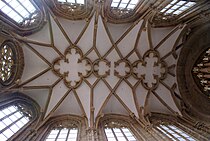 |
Tracery vaults in the Prince's Chapel, Moyses von Altenburg, Meissen Cathedral , Meissen |
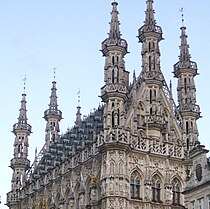 |
Tracery balustrades on eaves, sloping gables and galleries of the town hall of Löwen , 1448–1469 |
 |
Town hall in Bad Waldsee , pinnacle gable with tracery balustrade |
 |
Tracery crowning on a stepped gable , Mayor's House , 1538, Herford |
 |
Gable of the Schöppenkapelle of the Katharinenkirche in Brandenburg , crowned with tracery made of terracotta, 1st quarter of the 15th century. |
Wooden tracery
In the Gothic and then again in the neo-Gothic one likes designed wall coverings, secular furniture (chairs, cabinets and chests) and wooden furnishings for churches ( church pews , altars , pulpits and galleries ) with intricate carvings that were inspired by the Gothic tracery. These cabinetmakers -Work are therefore called tracery. Erhart Falckener , for example, often used finely carved tracery on the flat-cut surfaces of his church furniture.
Iron tracery
In the neo-Gothic period, tracery was also made of cast iron. The best-known example is the crossing tower of the Cathedral of Rouen , the 151.5 m high spire of which was made entirely of cast iron in 1877. Until the completion of Cologne Cathedral in 1880, Rouen had the tallest building in the world.
literature
- Günther Binding : tracery . Scientific Book Society, Darmstadt 1989, ISBN 3-534-01582-7
- Leonhard Helten: Medieval tracery. Origin - Syntax - Topology . Reimer, Berlin 2006, ISBN 3-496-01342-7 .
- Lottlisa Behling: Shape and history of the tracery (1st edition Halle ad Saale, 1944) 2nd edition Böhlau, Cologne 1978, ISBN 3-412-03077-5
- Christian Kayser: The construction of Gothic window tracery in Central Europe (studies on international architecture and art history), Petersberg 2012
Web links
- Examples of Gothic tracery
- Construction of Dreipass or Dreischneuß. (No longer available online.) Formerly in the original ; accessed on August 19, 2019 . ( Page no longer available , search in web archives )
- Ferdinand Luthmer, German Furniture of the Past (PDF; 19.1 MB)








